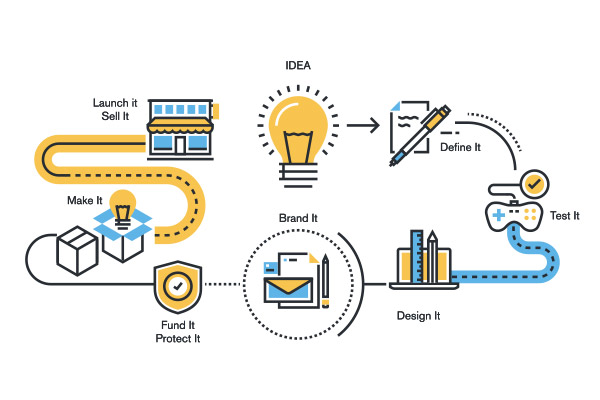Patent It Yourself: A Guide for Creators
With the right strategy, you can take charge of safeguarding your intellectual property, deciding to file a patent yourself. By understanding the methods and capitalizing on available resources effectively, one can navigate the often-complex patent system without solely depending on professional legal help.
We will discuss the key points for determining patent eligibility, looking into the criteria for patentability and reviewing the four categories of inventions. Next, we'll explore keeping an inventor's notebook to keep detailed records, ideally with witness signatures for additional security. We will also delve into how to conduct extensive research using online resources in order to perform thorough searches before officially submitting your application.
Afterwards, this article will look at the pros and cons of both regular patent applications (RPA) and provisional patent applications (PPA), assisting in making an informed choice. We will also examine situations where seeking out expert advice from IP lawyers might be necessary. Finally, we’ll touch upon utilizing the USPTO’s Manual of Patent Examining Procedure (MPEP) as a helpful source of knowledge when deciding to apply and patent it yourself.
Table of Contents
How to Qualify and Patent It Yourself
Novelty Aspect for Patents
Non-obviousness Requirements
Usefulness of Inventions
Performing Prior Art Research
Importance of Prior Art Search
Online Resources for Patent Investigations
When to Seek Advice from an IP Lawyer
Regular vs. Provisional Patent Application Types
Benefits and Drawbacks of RPAs
Benefits and Drawbacks of PPAs
Expanding Your Invention’s Territory
Discovering Alternative Techniques
Increasing Overall Value by Expanding Scope
Filing a Provisional Patent Application
Benefits of Submitting a Provisional Patent
Refining and Improving Your Invention During the 12-Month Period
Navigating USPTO’s Manual of Patent Examining Procedure
Comprehending Examiner Guidelines
Importance of Thorough Documentation
Conclusion
How to Qualify and Patent It Yourself
To be awarded a patent, your invention must satisfy the standards laid out by the United States Patent and Trademark Office (USPTO). It must be new, not obvious, and of use. It's important to document every phase of the inventive process with details within a notebook and have it verified by two reliable witnesses who are knowledgeable about your work, serving as proof for when you decide to pursue a patent on your own without professional help.
Novelty Aspect for Patents
To apply and patent it yourself, your invention must feature characteristics not found in any existing inventions or ideas, and not previously presented to the public. This means it can't have been revealed earlier in public resources like articles, books, or presentations before officially filing for the patent.
Non-obviousness Requirements
Beyond being new, an invention must not be obvious to an expert in its specific field. The USPTO will determine if the differences between your concept and existing knowledge would have been evident at the time you filed the patent to do it yourself.
Usefulness of Inventions
The final criterion demands that an invention possesses practical utility. It should offer a real-world benefit beyond just being interesting or aesthetically pleasing. For example, it could solve a problem more efficiently than previous methods.
Meeting these three standards improves your odds when you apply and patent it yourself through the USPTO. If you are uncertain about these standards, consider consulting with a knowledgeable patent attorney.
Inventors must establish that their invention is original and not easily deducible to be granted a patent. Prior art investigation can help assure the validity of your claims by identifying existing patents or publications related to the same concept. Next, we'll discuss how you can do prior art research yourself.
Safeguard your innovative ideas with a patent. Ensure novelty, non-obviousness, and utility to meet USPTO standards. Seek the help of a patent attorney if needed. #PatentItYourself #InnovationProtection Click to Tweet
Performing Prior Art Research
Thorough investigations into prior work in your field are critical to prevent infringement of existing patents or intellectual property rights held by others when aiming to apply and patent it yourself. The internet provides an excellent starting point when undertaking this type of research, but seeking professional help from intellectual property lawyers could prove beneficial if you are uncertain about aspects of prior art searches.
Importance of Prior Art Search
Avoids wasting resources on a non-patentable invention.
Establishes the novelty and non-obviousness of your invention when compared to existing technology.
Informs of enhancements or modifications to improve your patent application.
Online Resources for Patent Investigations
The following online databases are valuable for conducting patent searches:
USPTO Patent Full-Text Database (PatFT).
Espacenet – European Patent Office’s database.
World Intellectual Property Organization (WIPO) Global Brand Database.
When to Seek Advice from an IP Lawyer
If you encounter difficulties during your search or need assistance interpreting legal jargon, it's wise to consult an experienced IP lawyer who can guide you and ensure your invention receives suitable protection.

Performing prior art research is essential for innovators to protect their ideas and investments. Therefore, knowledge of the differences between regular and provisional patent applications is essential for innovators to safeguard their concepts and investments.
Protect your invention with a patent. Conduct thorough prior art research using online databases and seek guidance from an IP lawyer if needed. #PatentItYourself #InnovationProtection Click to Tweet
Regular vs. Provisional Patent Application Types
A Regular Patent Application (RPA) and a Provisional Patent Application (PPA) are the two primary choices when it comes to prepping your patent application for submission. Thoroughly evaluating the pros and cons of each choice is crucial before deciding.
Benefits and Drawbacks of RPAs
A Regular Patent Application calls for comprehensive descriptions, including claims that outline the distinguishing features of the invention. Drafting a full specification for an RPA can result in larger expenses owing to related legal fees. Also, once an RPA is filed, it becomes public information after 18 months from the filing or priority date.
Benefits and Drawbacks of PPAs
Provisional Patent Applications, on the other hand, offer creators more flexibility by giving 12 months before needing to submit all documentation together with any additional charges related to converting the PPA into an RPA later, if needed. A PPA does not require formal patent claims or declarations; nevertheless, it must include enough details so that someone familiar with the field can understand how to create and utilize the invention. A disadvantage is that PPAs offer no enforceable rights until they're converted to an RPA.
Regular patent applications give more complete protection than provisional patent applications but also necessitate more effort and money. By expanding the scope of your invention to incorporate alternate methods, you can amplify its overall value while leveraging available resources.
Take control of your invention’s patent process with these tips. Choose between Regular or Provisional Patent Applications to fit your needs. #PatentItYourself #Innovation Click to Tweet
Expanding Your Invention’s Territory
It is important to consider whether alternative methods exist for constructing your device or product, because this might potentially contribute to wider applications and increase the total worth of your patent protection. By finding other methods, you can keep your invention relevant and adaptable within a constantly evolving marketplace.
Discovering Alternative Techniques
Assess existing technologies within your field to uncover potential improvements or modifications.
Consider how different materials or manufacturing processes might influence the performance of your invention.
Explore the various potential uses for your invention across numerous industries, broadening its overall reach and effect.
Increasing Overall Value by Expanding Scope
A larger territory not only enhances an invention's commercial viability but also solidifies its standing against competitors. To achieve this, contemplate consulting with a patent attorney who has expertise in executing comprehensive searches and identifying any possible issues which might occur during the examination process. A skilled legal expert can assist you in navigating intricate details such as formulating claims and making certain that all required information is provided in the filing, increasing your odds of USPTO approval.
Besides working with a patent attorney, utilizing platforms such as Cypris – a research tool designed for R&D teams – can offer fast insights into useful data sources when developing new inventions.
Broadening your invention's scope can create a more significant item or administration and boost its overall worth. Filing a provisional patent application allows you to develop and enhance your invention throughout the 12 months prior to its formal assessment.
Broaden your invention’s scope and increase its value by identifying alternative methods. Consult with a patent attorney and use tools like Cypris for rapid insights.








Comments (1)